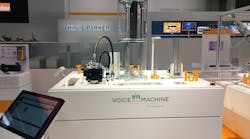Think about the Internet of Things and a host of big players come to mind, such as GE, Microsoft, Cisco and Amazon. Those companies are already finding enormous value in creating a connected manufacturing world. GE’s digital industrial business, for example, is expected to generate $20 billion in revenue by 2020.
But what about the small and medium-size manufacturers who make up the vast bulk of the manufacturing world? Is IoT something they can afford to adopt given often razor-thin margins and uncertainty about how they will benefit from connectedness in their workplaces?
Companies like Parker Hannifin (IW 500/87) were making just that case at the recent industrial fair Hannover Messe in Germany. Parker introduced its Voice of the Machine IoT platform, stressing that SMEs can start harnessing the benefits of IoT by adding sensors to individual components so that they can prevent costly downtime from failed pumps and other equipment, while also helping to ensure a safer workplace.
“Through the Voice of the Machine IoT platform we enable our customers to hear what their assets are saying at a component level so they can improve application performance,” said Miguel Morales, director, Internet of Things. “Parker has 100 years of component and system expertise for motion and control technologies, a prerequisite for unlocking that last mile of safety, reliability and productivity residing within the machines that our products support.”
Morales told IndustryWeek that there are enterprise IoT solutions that will solve important manufacturing problems but may take five years for a return on investment.
“We believe that innovation comes in solving small, discrete problems. As you collect solutions for these discrete problems, ensuring that they are interoperable and ensuring that they can plug into other environments is where you can start to prove quick and immediate results for IoT,” said Morales. He added that users will want to partner with companies such as Parker that have expertise in these components so that if they have trouble with a pump, for example, they can find out how to fix it much faster with that expertise to draw on.
Parker uses a component tagging system it calls Parker Tracking System to provide each component with a unique identifier and sensors that can feed information about equipment into the Voice of the Machine database. The database enables Parker to draw conclusions about how the equipment should operate in the field, compares that to actual performance and then can send out alerts or alarms on the IoT platform.
Parker customers can monitor specific issues, such as oil quality in a machine, through a sensor and the IoT platform. The system architecture is flexible so a customer, for example, can simply set a threshold for particulates in the oil and be alerted when that threshold is met, or it can write a script to run an analytical model that can take all the data from the component sensor and then send the alert.
Parker’s Voice of the Machine IoT platform is based on an IoT software platform, Murano, and an IoT marketplace, Exchange, developed by Exosite, an IoT software company headquartered in Minneapolis. The IoT platform is designed to help a diversified company like Parker develop a centralized approach to IoT implementation. The Exchange IoT marketplace provides a common repository of reusable software applications that can be used across the company. Thus, every division of Parker offering pumps, for example, can offer customers a condition monitoring application. Exosite says this reduces time to market and development costs significantly.
“Any company that has more than a couple product lines or business centers can benefit from a strategy of reuse and having a centralized approach like this,” said Mark Benson, Exosite’s chief technology officer.
Morales said the Voice of the Machine IoT platform extends Parker’s brand by codifying its large product catalog and industry expertise into a “digital experience.”
“We want to extend that brand to have a digital component, where a digital capability is part of our DNA and a part of our new product development’s DNA,” he said. “For every new product that comes out, if customers wants to include that in their connected ecosystem, Parker is providing that capability in-house.”





